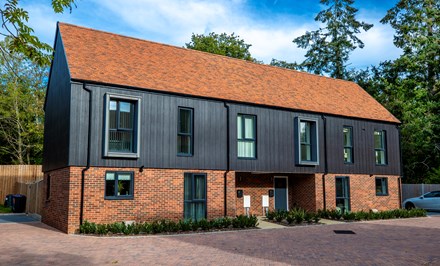Research commissioned by the Rural Housing Network, and supported by Hastoe Housing Association, has found that only a fraction of rural local planning authorities (17%) have made use of Rural Exception Sites to boost the supply of affordable housing in rural areas.
The research undertaken by a team of researchers based at the Bartlett School of Planning, University College London, looked at the reasons why Rural Exception Sites haven’t been fully utilised and outlines a number of recommendations to help successfully deliver affordable homes in rural areas.
Rural Exception Sites (RES) were introduced in 1991 to enable the development of affordable homes on underdeveloped land that would otherwise be restricted for residential development. The sites have the potential to provide much needed affordable housing amidst the escalating rural housing crisis. In 2022 rural rough sleeping increased by 24% and 300,000 people were on rural social housing waiting lists.
Out of 145 rural local authorities, only 25 used Rural Exception Sites to deliver affordable homes between 2021 and 2022, resulting in 546 homes being built. However, nearly 3,000 affordable homes could have been developed if the vast majority of rural councils had utilised rural expectation sites in the time period, presenting a massive, missed opportunity.
The under-use of Rural Exception Sites by some councils is a lost opportunity. By fostering knowledge, planning support, community partnership, and the dedication of Rural Housing Enablers, we can significantly enhance these vital resources for affordable rural housing.
Following a nationwide survey of local planning authorities, the study identified limited resources in planning departments, rising land costs, outdated development plans, and local opposition as common barriers to delivering affordable homes through Rural Exception Sites. These challenges were intensified by the long-standing financial disparity in rural areas.
To tackle these challenges, the report lays out several strategic recommendations for local planning authorities, policy makers and housing providers.
The recommendations include emphasising the importance of engaging with local communities early in the development process to garner support, as well as increasing the support and resources for Rural Housing Enablers. Where Rural Housing Enablers exist and are governed effectively, the delivery of Rural Exception Sites is systematically higher. Alongside this, the report recommends encouraging stronger partnerships between local authorities, developers, and communities, calling for policy adjustments, such as updating the National Planning Policy Framework, and advocating for additional funding and resources for rural planning authorities to effectively manage and support Rural Exception Site projects.
The underexploited potential of Rural Exception Sites represents a significant missed opportunity in tackling the rural housing crisis. By aligning strategic resources, enhancing policy frameworks, and fostering community partnerships, the full potential of this under-utilised policy can be harnessed and provide a sustainable and scalable answer to the affordable housing needs in rural England.
The experiences of so many rural communities offer stark examples of what happens when the housing market doesn’t meet local need. This research highlights a key route to help solve this issue. However, it also highlights the immense resource and funding pressures on local authorities across the country. We are urging policy makers and stakeholders to consider these recommendations and work together to help tackle the rural housing shortage.
Hastoe has developed homes on many Rural Exception Sites.
Read more about Odiham Parish Council's first Rural Exception Site
Rural exception sites are those where planning permission would not normally be granted, for example on the edge of a village. This reduces land costs and makes a development more financially viable. The lower land costs also enable sustainability features to be included which are of benefit to both residents and the environment. Another major benefit of RES schemes is that people with a local connection are given priority for the affordable homes, and they remain affordable for the local community in perpetuity.
Executive Summary and Report
Read the Executive Summary and full Report on the National Housing Federation's website.





